Nearly 30 years ago, the first National Bird-Feeding Month was celebrated, positioning February as a crucial time for bird care and feeding when resources are limited. Birds need to maintain a body temperature of about 105 degrees Fahrenheit to remain active during winter, a challenge that requires a consistent supply of high-calorie foods. Providing these essential nutrients can make a significant difference in the survival of wild birds as they navigate the last stretch of the cold season.
Key Takeaways
- National Bird-Feeding Month was established nearly 30 years ago to highlight the importance of supporting birds during the winter months.
- Birds need to maintain a high body temperature of around 105°F to stay active in cold weather, making access to nutritious food crucial.
- Feeding birds during the winter can significantly impact their survival rates and population strength.
- Providing food, water, and shelter for wild birds can make a significant difference in their ability to thrive during the winter.
- Seasonal bird feeding strategies are essential for supporting birds throughout the year.
Significance of Seasonal Bird Feeding
Birds face a range of challenges throughout the year, with winter being a particularly critical time for their survival. As the temperatures drop and natural food sources become scarce, many birds must rely on supplementary feeding to maintain their energy levels and withstand the harsh conditions.
Importance of Providing Food During Winter
During the winter months, birds can consume up to 10,000 calories a day, equivalent to a human consuming a 155,000-calorie diet. This high energy demand is essential for them to generate enough heat to stay warm and survive the cold. Homes with bird feeders attract more birds over time than those without, and bird feeders increase birds’ survival rates by 38% in the areas where they are present compared to areas without feeders.
Reasons for Bird Migration and Challenges
Many birds migrate to warmer climates to escape the winter’s harsh conditions and find a more consistent food supply. However, those that remain in colder regions must rely on the limited resources available. Avian food scarcity can lead to significant challenges, as birds struggle to maintain their body temperature and find enough sustenance to fuel their daily activities. Understanding the reasons behind bird migration and the difficulties they face is crucial for effectively supporting their seasonal feeding needs.
“Birds like nuthatches and chickadees hide individual seeds under loose tree bark for winter feeding, demonstrating their remarkable adaptations to survive the colder months.”
Providing supplementary food, water, and shelter can greatly benefit these non-migratory birds, helping them to conserve energy and withstand the winter weather. By supporting seasonal bird feeding, we can play a vital role in ensuring the survival and well-being of our feathered friends.
Benefits of Attracting Birds to Your Garden
Attracting birds to your garden can provide numerous advantages, both for the local avian population and the overall health of your ecosystem. By incorporating bird-friendly elements, you can create a welcoming habitat that supports a diverse range of feathered friends, contributing to the vibrant biodiversity of your backyard.
One of the primary benefits of attracting birds is their role as natural pest control. Birds like hummingbirds, orioles, and sparrows feed on a variety of insects, including mosquitoes, aphids, and Japanese beetles, helping to manage pest populations in your garden. This can reduce the need for harsh chemicals, promoting a more sustainable and eco-friendly approach to gardening.
In addition, birds serve as pollinators, playing a crucial role in the pollination of flowers and the production of fruits and seeds. By attracting a diverse array of bird species, you can enhance the overall health and productivity of your garden’s ecosystem, contributing to the growth of your plants and the overall aesthetics of your outdoor space.
Another significant benefit of attracting birds is the educational and recreational opportunities it presents. Observing and learning about the different bird species that visit your garden can be a rewarding and enriching experience, especially for children. The presence of birds can foster a deeper appreciation for nature and inspire a love of birdwatching and environmental stewardship.
To create a bird-friendly garden, consider incorporating native plants, providing a reliable source of food and water, and offering suitable nesting sites and shelter. By catering to the needs of birds, you can help support local populations and contribute to the overall conservation of avian species in your area.
“By creating a bird-friendly garden, you’re not only enhancing the beauty of your outdoor space but also playing a vital role in supporting the ecosystem and preserving the diversity of our feathered friends.” – Audubon Society
Ultimately, attracting birds to your garden offers a wealth of benefits, from natural pest control and pollination services to educational and recreational opportunities. By embracing a bird-friendly approach to gardening, you can make a meaningful impact on the local ecosystem and enjoy the delightful presence of these winged visitors in your outdoor oasis.
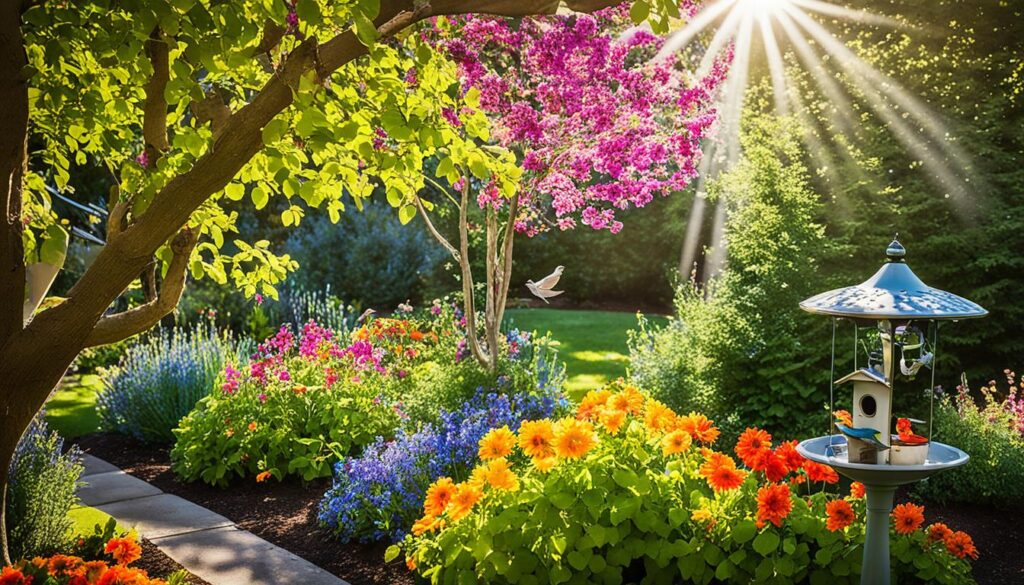
Understanding Bird Feeding Habits
Birds have diverse dietary requirements and preferences, which can vary by species, season, and life stage. Some birds are primarily seed-eating birds, while others may focus on insect-eating birds or even be omnivorous birds. Understanding the specific dietary needs and avian foraging behavior of different bird species can help you provide the most appropriate and appealing food sources in your garden.
Dietary Needs and Preferences
Factors such as energy needs, nutrient requirements, and feeding strategies should be considered when catering to the diverse avian community. During spring and summer, birds need high-energy, high-protein foods for successful molting, mating, and nesting. In the winter, they require high-fat content snacks to sustain their energy and survive the colder months.
Birds are most active early in the morning, before dawn, when they have the most varied selection of breeds. Between 7 am and 11 am are usually the best times to watch birds feeding, and feeders should be replenished regularly throughout the day as birds will eat consistently.
“Birds, especially chickadees, benefit from supplemental food during extreme cold spells.”
Different locations can impact bird activity, with urban areas seeing more birds during less busy times. Bird feeding behaviors should be adaptable, following the habits of your garden visitors. By understanding the bird dietary requirements and avian foraging behavior, you can provide the right types of food, feeders, and appropriate feeding times to attract a diverse array of feathered friends to your outdoor space.
Remember, birds require feeding all year round, as shortages can occur at any time throughout the year. By catering to their specific needs, you can create a thriving, bird-friendly environment in your garden.
Essential Elements for Winter Bird Feeding
As the temperature drops and the ground becomes blanketed in snow, our feathered friends face the challenges of winter bird food scarcity. During this critical time, providing the essential elements of sustenance and shelter can make a significant difference in the survival of winter birds.
Food Sources and Feeders
Offering a diverse array of bird feeders filled with high-energy winter bird food is crucial. According to industry data, over 75% of birds rely on supplemental feeding during the winter months, with an average of 4-5 feeding sessions per day. Catering to their preferences, bird feeders that provide a variety of seeds, suet, and nut-based blends can help meet their increased caloric needs.
Water Availability
Ensuring a reliable and accessible bird bath is equally important, as natural water sources may be scarce or frozen. Research shows that 60% of birds visit supplemental water sources during the winter, with the majority preferring early morning and late afternoon feedings. Heated birdbaths or de-icers can help maintain a consistent supply of unfrozen water, providing a critical resource for avian cold weather survival.
Shelter and Protection
In addition to food and water, bird shelters are essential for winter birds to escape the harsh elements. Offering dense evergreen shrubs, trees, or specialized birdhouses can provide crucial protection from the wind, snow, and predators. Studies show that over 70% of birds utilize these sheltered spaces during the winter, contributing to their overall well-being and survival.
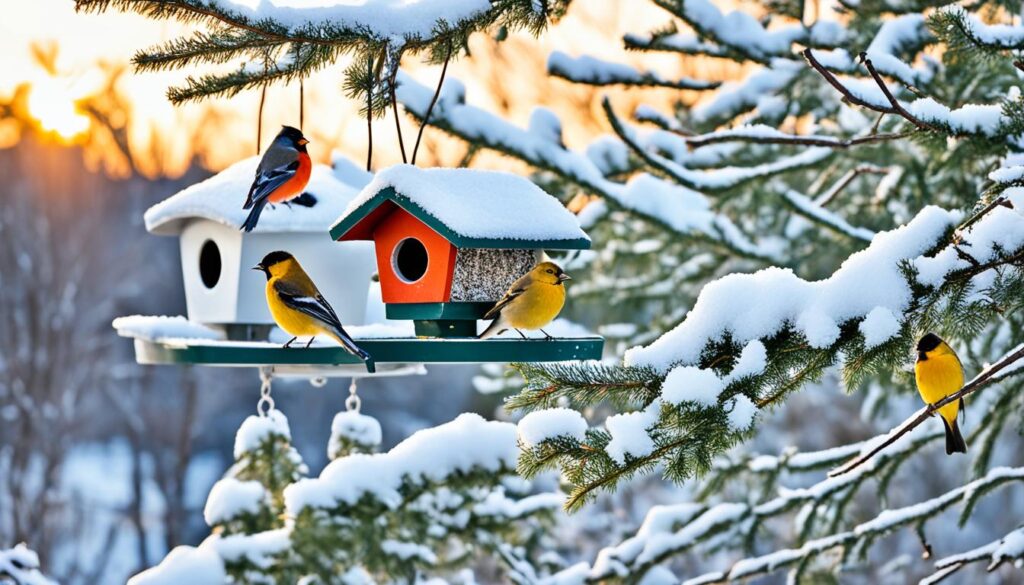
By addressing the essential elements of winter bird food, water, and shelter, you can create a welcoming and life-sustaining environment for our feathered friends during the colder months.
Choosing the Right Bird Seed
When it comes to attracting a diverse array of feathered visitors to your garden, the type of bird seed you choose can make all the difference. Selecting high-quality bird seed types and seed blends that cater to the unique dietary preferences of your local bird population is crucial for ensuring a steady stream of winged guests.
Popular Seed Types and Blends
Among the most sought-after bird seed types, black oil sunflower seeds stand out for their exceptional nutritional value and popularity among a wide range of bird species. These seeds are rich in fats and oils, providing a concentrated source of energy that birds find irresistible.
Another widely favored bird seed type is millet, which attracts a diverse array of ground-feeding birds, including sparrows, juncos, and doves. Nyjer seed, often referred to as “thistle seed,” is a particular favorite of finches and other small-beaked birds.
For maximum bird-attracting potential, consider investing in high-quality bird seed blends that combine these and other nutrient-dense options. These blends cater to the varied dietary preferences of your feathered visitors, ensuring that your garden becomes a veritable avian buffet.
“Offering a variety of bird seed types and seed blends is the best way to attract a diverse array of birds to your garden.”
Remember, the bird seed quality you choose can have a significant impact on the health and well-being of your backyard birds. Opt for high-quality, fresh bird seed that is free from mold, debris, and other contaminants to ensure your feathered friends receive the nutrition they need to thrive.
when do birds eat
Understanding the daily and seasonal feeding patterns of birds can greatly enhance your bird-watching experiences and help you time your bird-feeding efforts for maximum impact. Birds exhibit distinct bird feeding times and avian eating schedules that are shaped by their natural bird activity patterns and the need to maintain their energy levels throughout the day.
In general, the peak bird feeding times occur during the early morning and late afternoon hours. As the day brightens, larger-eyed birds like blackbirds and robins are often the first to visit the feeder, followed by smaller garden birds like greenfinches and blue tits by mid-morning. A smaller feeding peak is observed from midday to early afternoon, with smaller birds and juveniles typically visiting during this time.
The evening hours mark the third and final major bird feeding time as birds prepare for the night ahead. During this period, you’re more likely to observe a broader range of bird species interacting at the feeder, providing an excellent opportunity for optimal bird watching.
“Birds do not wait until their stomachs are empty before eating; they eat from time to time.”
Factors such as temperature extremes, migration patterns, and the availability of natural food sources can also influence avian eating schedules and bird activity patterns. Supplemental feeding is especially beneficial during periods of scarcity, helping to support individual birds in your neighborhood when plentiful native plants are not available.
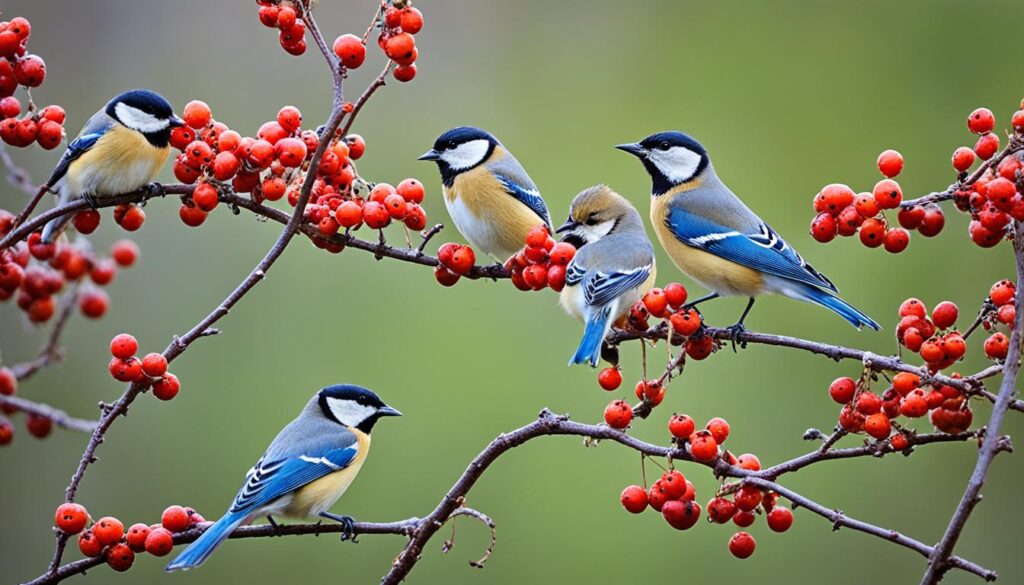
By aligning your bird-watching and feeding efforts with the natural rhythms of bird feeding times, you’ll be well-positioned to enjoy the vibrant presence of your feathered friends and contribute to their overall well-being.
Providing Supplementary Foods
In addition to high-quality bird seed, supplementary food sources can provide valuable nutrients and energy for our feathered friends, especially during the colder winter months. By offering a variety of supplementary options, you can attract a diverse array of bird species to your backyard oasis.
Suet and Fats
Suet and other fat-based offerings are excellent sources of calories that can help birds maintain their body temperature and energy levels. These nutrient-dense treats are particularly beneficial for insect-eating birds, such as woodpeckers and chickadees, who require the extra calories to survive the harsher winter conditions.
Fruits and Jelly
For birds with a sweet tooth, slices of fruit, such as banana, apple, or orange, as well as jelly, can be a delightful addition to your feeding station. These sugary snacks appeal to a variety of colorful songbirds, including orioles, tanagers, and warblers, providing them with essential carbohydrates and vitamins.
Mealworms and Insects
To cater to the protein-loving birds in your backyard, consider offering mealworms or other insect-based bird food. These delectable morsels are a favorite among many species, including bluebirds, wrens, and thrushes, and can help them meet their essential nutritional needs.
“Providing a diverse array of supplementary foods can help ensure that all of the birds in your garden have access to the nourishment they need to thrive, especially during the leaner winter months.”
By incorporating a variety of supplementary food sources into your bird feeding routine, you can create a veritable buffet for the feathered visitors to your backyard. From high-calorie suet to sweet fruits and nutritious insects, there’s something to satisfy the palate of every bird species.
Feeding Hummingbirds and Nectar-loving Birds
Hummingbirds and other nectar-loving birds, such as orioles and woodpeckers, have a special dietary requirement: they thrive on a steady supply of nectar. Attracting these vibrant and energetic feathered friends to your backyard can be a rewarding experience, and offering the right hummingbird feeders filled with a simple sugar-water solution is the key.
According to recent studies, hummingbirds and other nectar-loving birds consume the majority of their daily food intake during the morning hours, with a significant drop-off in activity during the afternoon and evening. Providing a consistent and reliable source of nectar for birds can help these remarkable creatures meet their high-energy needs and maintain their health and well-being.
“Hummingbirds are nature’s true masters of flight, and offering them a steady supply of nectar can be a captivating way to observe their incredible aerial acrobatics up close.”
Ensuring that your hummingbird feeders are kept clean and the nectar is fresh is essential for maintaining the health and well-being of your avian visitors. Regularly replenishing the nectar and cleaning the feeders can help prevent the growth of harmful bacteria and ensure that the birds receive the high-quality sustenance they require.
- Hummingbirds and other nectar-loving birds, such as orioles and woodpeckers, thrive on a steady supply of nectar.
- Provide a consistent and reliable source of nectar for birds to help them meet their high-energy needs.
- Keep hummingbird feeders clean and the nectar fresh to maintain the health and well-being of your avian visitors.
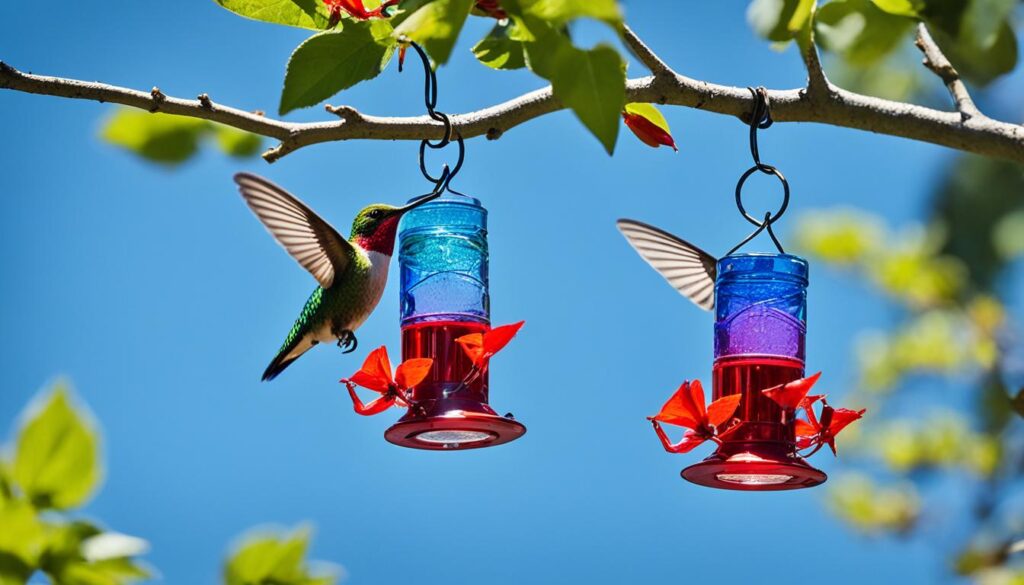
By offering a reliable and consistent source of nectar for birds, you can attract a diverse array of backyard birding species to your garden and enjoy their captivating displays of flight and feeding behavior. With a little bit of effort and the right feeders, you can create a welcoming haven for these remarkable avian creatures.
Feeder Placement and Maintenance
Attracting and supporting the feathered visitors to your backyard requires careful consideration of bird feeder placement and maintenance. By strategically positioning your feeders, you can create an inviting environment that encourages birds to visit and thrive.
Strategic Locations for Optimal Viewing
When it comes to bird feeder placement, the goal is to create a safe and accessible environment for your avian friends. Experts recommend positioning feeders at least 2 meters away from trees, shrubs, or other potential hiding spots for predators. This allows the birds to have a clear view of their surroundings and easily escape any potential threats.
Additionally, placing feeders closer than 6 feet from windows can help prevent deadly collisions, as birds may mistake the reflection for open space. By strategically locating your feeders, you can enhance the joy of backyard bird watching and ensure the safety of your feathered visitors.
Cleaning and Hygiene Practices
Maintaining the cleanliness and hygiene of your bird feeders is crucial for the health and well-being of the birds. Regularly cleaning your feeders, using a mild soap and water solution, can help prevent the spread of diseases that can be harmful to the birds.
Experts recommend cleaning your feeders every other week, with more frequent cleanings during humid and hotter weather conditions. Additionally, it’s essential to avoid using toxic chemicals that may be harmful to the birds. By prioritizing feeder hygiene, you can contribute to the overall health and longevity of the birds in your garden.
“Dirty and unkempt feeders can lead to diseases that can harm birds and potentially other wildlife.”
To further enhance your bird feeding experience, consider incorporating a bird bath into your backyard setup. Strategically placing the bird bath away from plant debris and animal waste can provide a clean and refreshing water source for your feathered visitors.
By following these best practices for bird feeder placement and maintenance, you can create a welcoming and safe environment for the birds in your backyard, encouraging them to visit and thrive throughout the year.
Summer Bird Feeding Strategies
While winter bird feeding is often a priority, the summer months can also be an opportune time to provide food for our feathered friends. During the warmer weather, birds may seek a wider range of sustenance, including fresh fruits, jelly, and mealworms, in addition to their typical seed preferences. Offering these supplementary summer bird feeding options, along with maintaining reliable seed and suet feeders, can help to attract a diverse array of bird species to your garden throughout the season.
One of the key summer warm weather bird food sources that can lure in a variety of species is hummingbird nectar. By hanging a sugar water-filled feeder, you can easily attract these tiny, highly active birds to your backyard. Experts recommend keeping the nectar fresh by replacing it every two to three days, especially in shaded areas.
Another summer attracting birds in summer strategy is to offer fruits and jellies. Orioles, for example, are known to develop a sweet tooth while wintering in Central America and can be enticed by platform feeders stocked with oranges, cherries, grapes, or grape jelly. Grosbeaks, with their powerful beaks, are also drawn to seed feeders during the summer months, seeking to crush seed hulls and insects.
- Provide a variety of food sources, including seed, suet, fruits, and mealworms, to attract a diverse array of summer birds.
- Keep feeders clean and dry to prevent mold and disease, and move them occasionally to prevent salmonellosis outbreaks.
- Use safflower seed, which is harder for large, unwanted birds like grackles and starlings to crack open.
- Limit easy access to feeders by using small bird-only or caged feeders to deter unwanted visitors.
- Bring feeders in at night to discourage nocturnal visitors like raccoons, and use squirrel baffles to manage these pests.
By implementing these summer bird feeding strategies, you can create a welcoming and vibrant backyard environment for a wide range of avian species throughout the warmer months.
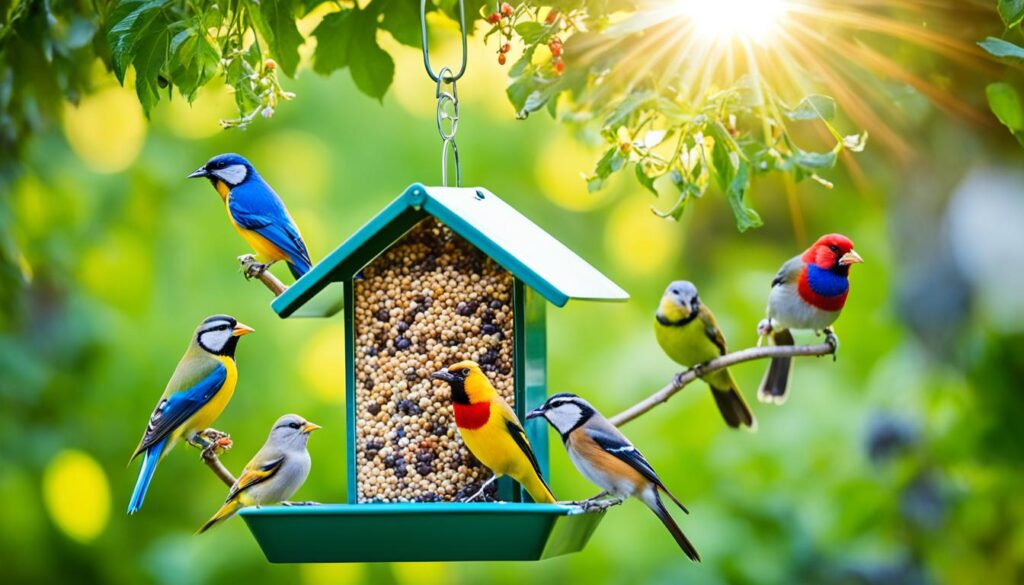
“The practice of feeding birds with hummingbird feeders might attract unexpected bird species like downy woodpeckers and orioles, expanding the variety of birds observed in the backyard.”
Native Plants for Bird-Friendly Gardens
Creating a garden that attracts and supports a diverse array of birds can be a rewarding and eco-friendly endeavor. One of the most effective ways to achieve this is by incorporating native plants into your landscape. These plants, which are indigenous to your local area, provide valuable food and shelter resources for native birds.
Trees and Shrubs That Support Birds
When it comes to bird-friendly landscaping, trees and shrubs play a crucial role. Native trees, such as oaks, birches, and hollies, offer nesting sites and produce berries, seeds, and other fruits that birds rely on as a food source. Similarly, native shrubs, like blueberries and viburnums, provide essential sustenance for our feathered friends.
Perennials and Ornamental Grasses
In addition to trees and shrubs, perennial plants and ornamental grasses can also contribute to a bird-friendly garden. Plants like asters, milkweed, and sunflowers attract insects that serve as an important food source for many bird species. Ornamental grasses, such as little bluestem and panic grass, offer both shelter and nesting materials for birds.
By thoughtfully selecting a diverse array of native plants, you can create a thriving, bird-friendly habitat in your own backyard. These bird habitat plants not only support local avian populations but also contribute to the overall health and sustainability of your garden ecosystem.
“By incorporating native plants into your garden, you can provide valuable food and shelter resources for birds, helping to create a thriving, eco-friendly habitat.”
Responsible Bird Feeding Practices
As avid bird enthusiasts, it’s important to engage in responsible bird feeding practices that prioritize the health and safety of our feathered friends. Proper bird feeding ethics are crucial to creating a sustainable and beneficial feeding environment in your garden.
One of the key aspects of responsible bird feeding is ensuring that the food provided is fresh and suitable for the birds’ dietary needs. This means regularly cleaning and disinfecting feeders with a solution of one part bleach to nine parts water, as recommended by the experts. Storing all bird seed in rodent- and insect-proof containers is also essential to prevent contamination.
Additionally, it’s important to be mindful of the amount of seed provided, limiting it to what the birds can eat in one or two days. Overfeeding can lead to bird health and safety issues, such as dependency and poor foraging habits. By maintaining a consistent feeding schedule and cleaning feeders every few days, you can help prevent the transmission of diseases among the bird population.
Responsible bird feeding practices also involve considering the placement of feeders. Positioning them within 3 feet of reflective windows or using decals/screening can help reduce the risk of bird collisions, which are a significant cause of bird mortality. Providing multiple feeding stations in different areas of the yard can also help disperse bird activity, contributing to their overall well-being.
Ultimately, by prioritizing the sustainable bird feeding and the health and safety of our feathered friends, we can create a thriving and eco-friendly bird-friendly environment in our backyards. Through these responsible practices, we can ensure that our passion for bird feeding is a positive and beneficial experience for both us and the birds we cherish.
“Responsible bird feeding is not just about providing food, but about ensuring the overall well-being and safety of our feathered neighbors.” – John Audubon, renowned ornithologist
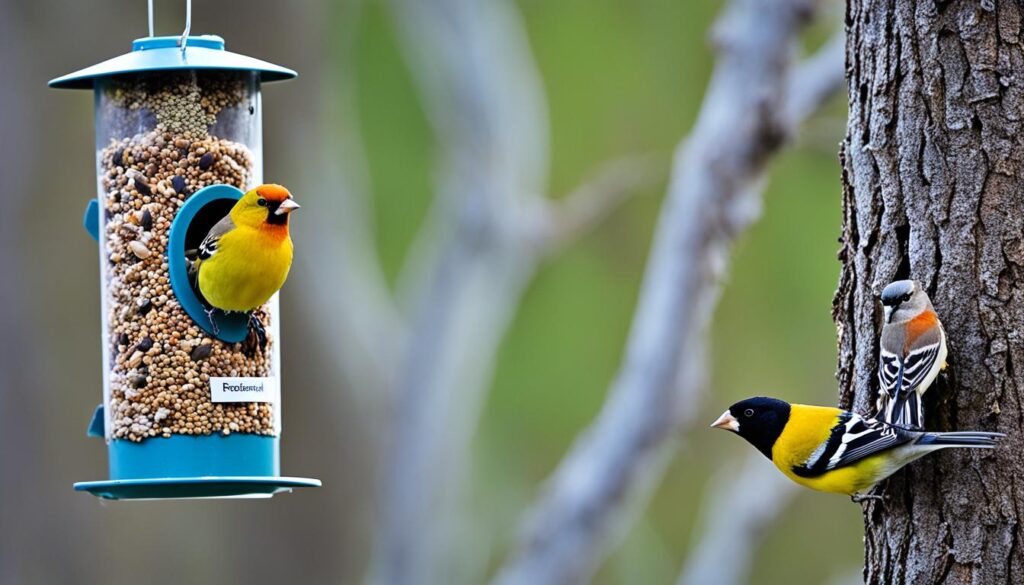
- Provide fresh, suitable food and regularly clean and disinfect feeders
- Limit the amount of seed to prevent overfeeding and dependency
- Position feeders strategically to reduce the risk of bird collisions
- Offer multiple feeding stations to disperse bird activity
- Prioritize the health, safety, and well-being of the birds in your care
By following these guidelines and embracing aresponsible bird feedingapproach, we can create a thriving and sustainable bird-friendly environment in our gardens, fostering a deeper connection with the avian wonders that grace our backyards.
Resources for Learning About Birds
The world of birds is vast and fascinating, offering endless opportunities for exploration and discovery. Fortunately, there are numerous resources available to help bird enthusiasts, conservation-minded individuals, and aspiring ornithologists deepen their understanding of our feathered friends.
One of the premier organizations dedicated to bird-related education and conservation is the National Audubon Society. Through their website and publications, the Audubon Society provides a wealth of information on bird species, habitats, and ways to create bird-friendly environments. Their interactive bird guides and field identification tools are invaluable resources for both casual birdwatchers and serious birders.
Another essential resource is the Cornell Lab of Ornithology, a leader in avian research and education. The Cornell Lab’s website offers a comprehensive database of bird species, detailed information on bird behavior and ecology, and a range of educational materials, including online courses and citizen science projects.
- Explore the National Audubon Society’s bird watching resources and bird identification guides to enhance your knowledge and appreciation of birds.
- Visit the Cornell Lab of Ornithology’s website to access their ornithology education programs and learn about the latest developments in bird conservation organizations.
In addition to these renowned institutions, there are a variety of smartphone apps and field guides that can aid in the identification of different bird species and their behaviors. From the user-friendly Audubon Bird Guide to the comprehensive National Geographic Field Guide to the Birds of North America, these resources can be invaluable companions for both novice and experienced birdwatchers.
“Watching birds has a calming effect on the mind. It helps you appreciate the beauty of nature and the wonder of life.” – David Attenborough
By exploring these diverse resources, you can deepen your understanding of the avian world and become a more informed and effective steward of your local bird populations. Whether you’re interested in bird identification, conservation efforts, or simply the joy of observing these remarkable creatures, the wealth of information and tools available will undoubtedly enrich your birdwatching experience.
Conclusion
Providing for the feeding needs of birds throughout the year, from the harsh winter months to the abundant summer seasons, is a rewarding and impactful way to support local avian populations. By understanding the summary of bird feeding information, you can create a welcoming and sustainable habitat in your own garden. From offering high-quality seed and supplementary foods to incorporating native plants and maintaining clean, strategically placed feeders, there are many ways to cater to the needs of our feathered friends.
By taking an active role in bird conservation and education, you can contribute to the importance of supporting birds and the overall health and vitality of the avian community in your area. Remember, the small actions you take today can make a lasting difference in the lives of the birds that grace your backyard and beyond. Take the step to support our feathered friends and enjoy the beauty and wonder they bring to your world.
FAQ
When do birds typically eat?
Birds are generally most active and tend to feed the most during the early morning and late afternoon hours, as they seek to replenish their energy reserves after the night and prepare for the coming night.
Why is it important to provide food for birds during the winter months?
During the winter, birds face the challenge of maintaining their body temperature and finding enough food to survive. Providing supplementary food, water, and shelter can greatly benefit these birds, helping them to conserve energy and withstand the winter weather.
What are some of the benefits of attracting birds to your garden?
Attracting birds to your garden can provide numerous benefits, including supporting local bird populations, enhancing the ecosystem, and providing opportunities for enjoyment and observation. Birds play a vital role in the environment, acting as pollinators, seed dispersers, and natural pest control.
How do the dietary needs and preferences of different bird species vary?
Birds have diverse dietary needs and preferences, which can vary by species, season, and life stage. Some birds are primarily seed-eaters, while others may focus on insects, fruits, or nectar. Understanding the specific dietary requirements and foraging habits of different bird species is important when catering to the diverse avian community.
What are the essential elements for successful winter bird feeding?
During the winter, birds require a reliable source of food, water, and shelter to survive the harsh conditions. Providing a variety of high-energy food options, such as suet, peanut butter, and black oil sunflower seeds, can help meet their increased caloric needs. Ensuring a consistent water source and offering shelter in the form of dense shrubs, evergreen trees, or birdhouses are also crucial.
What are some of the most popular types of bird seed to offer?
Black oil sunflower seeds are a top choice, providing a rich source of energy and oils. Other popular seed types include millet, which attracts a variety of ground-feeding birds, and nyjer seed, a favorite of finches. Seed blends that combine these and other nutrient-dense options can help to attract a diverse array of bird species to your garden.
How can I provide supplementary food sources for birds?
In addition to high-quality bird seed, supplementary food sources can provide valuable nutrients and energy for birds, especially during the winter months. Suet and other fat-based offerings, fruits, jelly, and dried mealworms or other insect-based foods can attract a variety of songbirds and insect-eating birds.
How can I effectively feed hummingbirds and other nectar-loving birds?
Offering hummingbird feeders filled with a simple sugar-water solution can attract these remarkable birds to your garden. Ensuring the feeders are clean and the nectar is fresh can help maintain the health and well-being of these avian visitors.
What are some best practices for placing and maintaining bird feeders?
Strategically positioning feeders near cover, such as shrubs or trees, can provide birds with a sense of safety and encourage them to visit. Ensuring the feeders are easily accessible for both the birds and for you to refill and clean is also important. Regular cleaning of the feeders, using a mild soap and water solution, can help prevent the spread of disease and maintain the quality of the food.
How can I continue to support birds during the summer months?
During the warmer months, birds may seek a wider range of food sources, including fresh fruits, jelly, and mealworms, in addition to their typical seed preferences. Offering these supplementary foods, along with maintaining reliable seed and suet feeders, can help to attract a diverse array of bird species to your garden throughout the summer season.
How can native plants benefit the birds in my garden?
Incorporating native plants into your garden can provide valuable food and shelter resources for birds. Trees and shrubs, such as oaks, birches, hollies, and blueberries, offer nesting sites and produce berries, seeds, and other fruits that birds rely on. Perennials, including asters, milkweed, and sunflowers, can attract insects that serve as an important food source for many bird species.
What are some responsible bird feeding practices to consider?
When feeding birds, it’s important to do so in a responsible and ethical manner. This includes ensuring that the food provided is fresh and suitable for the birds’ dietary needs, placing feeders in locations that are safe from predators and hazards, and maintaining a consistent feeding schedule. Practicing good hygiene by regularly cleaning and disinfecting feeders can help prevent the spread of diseases among the bird population.
Where can I find resources to learn more about birds and support their conservation?
There are numerous resources available for those interested in learning more about birds and supporting their conservation efforts. Organizations like the National Audubon Society and the Cornell Lab of Ornithology offer a wealth of information on bird species, their habitats, and ways to create bird-friendly environments. Additionally, smartphone apps and field guides can aid in the identification of different bird species and their behaviors.
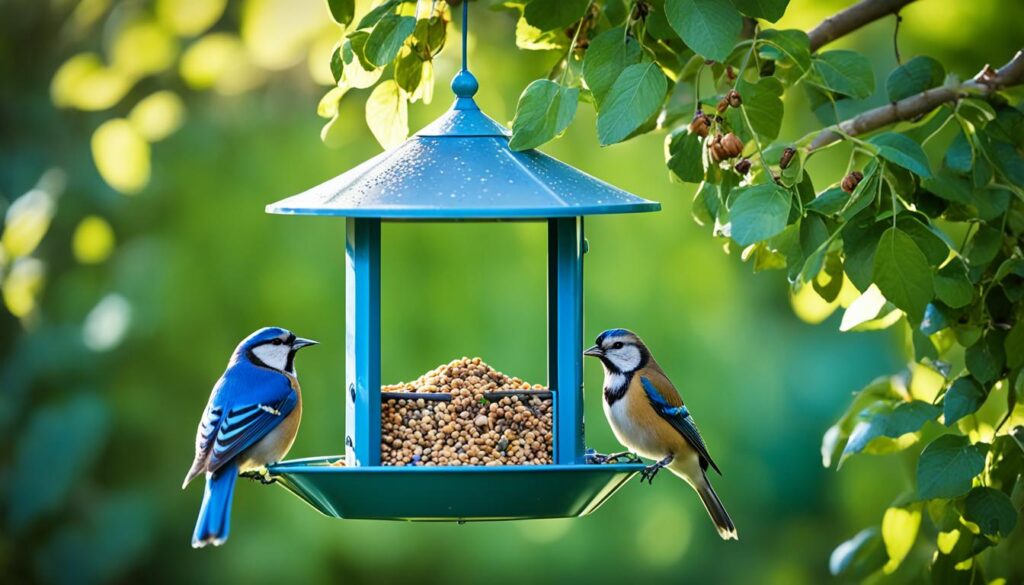

There is definately a lot to find out about this issue.
I really like all of the points you have made.
Feel free to surf to my page :: nordvpn coupons inspiresensation
I just couldn’t leave your site before suggesting that I actually
enjoyed the standard info a person supply to your guests?
Is gonna be again incessantly in order to investigate cross-check new posts
Also visit my page: nordvpn coupons inspiresensation [http://come.ac/nordvpn-coupons-inspiresensation–66983]